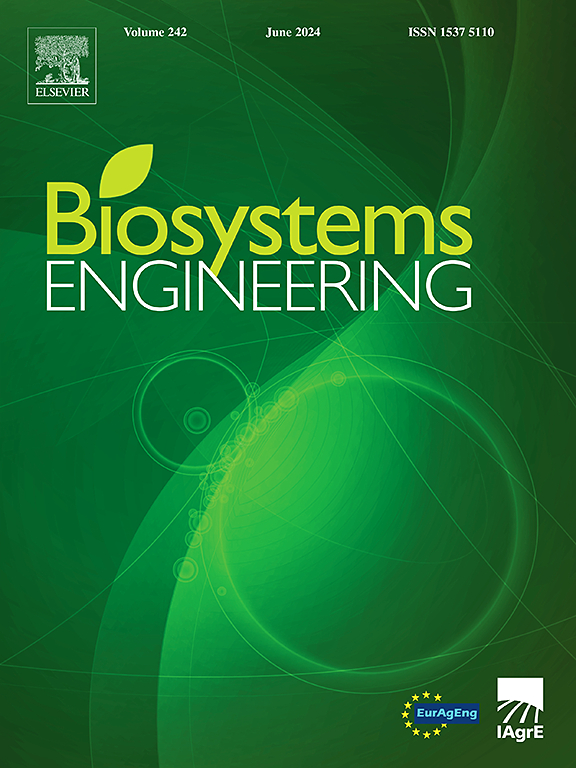基于少次学习和不确定性预测的作物单叶光合作用估算方法
IF 5.3
1区 农林科学
Q1 AGRICULTURAL ENGINEERING
引用次数: 0
摘要
准确、高效地评估单叶光合速率对作物产量评估、逆境感知和生物育种具有重要意义。然而,现有的人工智能预测方法通常需要大量的训练数据,并且往往依赖于点估计,这对少镜头学习和高可靠性预测提出了挑战。为了缓解这一困境,本研究开发了一个综合的人工智能估计模型。该模型结合了元学习(ML)和多层感知器(MLP),首先构建了一个基本预测模型,然后对其进行微调,以适应未知的任务。与目前流行的方法相比,该模型在训练样本较少的情况下实现了更高的预测精度。仅从数据集中引入约5%的新样本就足以获得令人满意的预测性能。此外,本研究引入分位数回归(QR)方法,获得了ai的95%置信区间,缓解了预测高可靠性的局限性。最后,利用高斯核密度估计(GKDE)推导出各环境条件下的概率密度,构建了具有可靠不确定性估计能力的人工智能预测模型。通过多物种数据集的详细验证和可解释性分析,证明了该方法具有普遍适用性和合理性。本研究突出了ML-MLP对未知数据集的高泛化能力,并将人工智能预测从点估计扩展到QR-GKDE的区间预测,从而促进了作物种植的研究。本研究通过为作物监测和压力感知提供可靠的方法,显著提高了精准农业。本文章由计算机程序翻译,如有差异,请以英文原文为准。
Method for estimating single-leaf photosynthesis in crops considering few-shot learning and uncertainty prediction
Accurate and efficient assessment of single-leaf photosynthetic rate (AL) is essential for applications in crop yield assessment, stress perception, and biological breeding. However, existing AL prediction methods typically require extensive training data and often rely on point estimation, which poses challenges for few-shot learning and high-reliability predictions. To alleviate this dilemma, a comprehensive AL estimation model was developed in this study. Using the combination of meta-learning (ML) and multilayer perceptron (MLP), the model initially constructed a base prediction model and then fine-tuned it for unseen tasks. Compared to the current popular methods, the proposed model achieved higher prediction accuracy with fewer training samples. Introducing only about 5 % of new samples from the dataset was sufficient to achieve satisfactory predictive performance. Additionally, this study introduced quantile regression (QR) method to obtain the 95 % confidence interval of AL, mitigating the limitations of high reliability in predictions. Finally, by employing Gaussian kernel density estimation (GKDE) to derive the probability density under each environmental condition, we constructed an AL prediction model with reliable uncertainty estimation capabilities. Through detailed validation using multiple datasets from various species and interpretability analysis, the proposed method has proven to be universally applicable and reasonable. This research highlights the high generalization ability of ML-MLP for unseen datasets and extends AL predictions from point estimation to interval prediction by QR-GKDE, thereby facilitating the researches on crop cultivation. This research significantly enhances precision agriculture by providing robust methodologies for crop monitoring and stress perception.
求助全文
通过发布文献求助,成功后即可免费获取论文全文。
去求助
来源期刊

Biosystems Engineering
农林科学-农业工程
CiteScore
10.60
自引率
7.80%
发文量
239
审稿时长
53 days
期刊介绍:
Biosystems Engineering publishes research in engineering and the physical sciences that represent advances in understanding or modelling of the performance of biological systems for sustainable developments in land use and the environment, agriculture and amenity, bioproduction processes and the food chain. The subject matter of the journal reflects the wide range and interdisciplinary nature of research in engineering for biological systems.
 求助内容:
求助内容: 应助结果提醒方式:
应助结果提醒方式:


